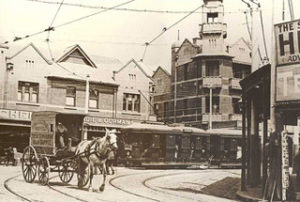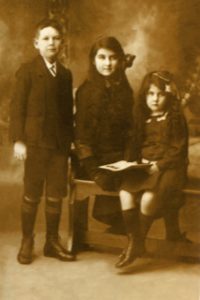By Judy Chant
My only memory of my maternal Great Grandmother is that of a seemingly grumpy, white-haired woman, lying in bed in a darkened bedroom at the back of my Grandma’s house at Wiley Park. As a three-year old child in 1955, quietness was mandatory so as not to disturb this old woman, who commanded the authority and respect of everyone in the house. It’s only as a grandmother myself that I have come to glimpse the vivacious woman behind the sad veneer, one who knew the sorrow of acting outside social and religious norms.
Elizabeth Punch, known as Lizzy, was born in Sydney on 31st January, 1875. She was the sixth of eleven children born into the Irish Catholic family of Edward Joseph Punch of Cork, Ireland and Mary (nee Hill) of Sydney, who converted to Catholicism for the love of her life. The Punch girls attended day school and learned the piano, while the boys boarded at St Joseph’s College at Hunters Hill. Lizzy commented to her daughter that drinking and smoking at school seemed high on the agenda of the boys. Lizzy was born into a family of high achievers – publicans, elite sportsmen, a politician, an author and a couple of well known actors. They were also rowers and their achievements were noted in the newspapers. Lizzy was a proud, self-confident lady and her father, Edward, was a well-known figure in business circles, establishing the Flinders Hotel in Darlinghurst and the Tea Gardens Hotel at Bondi Junction, where patrons would go to ‘take the air’. The children grew up in the Tea Gardens Hotel. Although swimming during daylight hours was forbidden prior to 1903, the sea air was believed to have restorative qualities. The racehorse legend, Phar Lap, was stabled in the hotel grounds at one time.

On 15th April 1896, twenty one year old Lizzy married John Edward McFadyen (1871-1943) at St Francis Church, Paddington. The bride “looked charming in a costume of grey crepon, front and trimmings of satin brocade outlined with gold and blue revers, and epaulets of grey velvet – the full jabot was composed of crepe de chine – with a picture hat of white chiffon, butter colour straw, high crown, and stylish loops of pale blue chene silk and white ostrich plumes. She carried a lovely shower bouquet of white flowers and maidenhair” (Sunday Times, 26 April 1896). The couple honeymooned at Katoomba, in the Blue Mountains, west of Sydney. John was an Accountant, the son of a Scottish Presbyterian farmer at Narrowgut, on the outskirts of the picturesque town of Morpeth, NSW. The combination of an urban Catholic and rural Presbyterian union was not uncommon, reflecting the times when farming families were moving off the land and migrating to the city. John and Lizzy lived in a fashionable Paddington terrace house, where they produced three children, Eileen, Majorie and Jack. Sadly, Lizzy found herself married to a man with a drinking problem. The situation became so bad that she made the heartrending decision that she and the children couldn’t live in an environment fuelled with alcohol. In a very religious age, Lizzy took the unusual step of separating and then divorcing her husband of twelve years. In December 1908, she petitioned for the dissolution of her marriage on the grounds of ‘habitual drunkenness and habitual neglect to support the petitioner’. In April 1909, a decree nisi, returnable in six months, was pronounced. Lizzy became a single parent, in an era when a woman’s identity was largely interlinked with that of her husband. Despite great emotional, religious and financial pressure, Lizzy chose the difficult path of becoming an independent woman. The legal endorsement of patriarchy ensured her path was fraught with financial problems and there was no superannuation safety net.

circa 1910
Seven years after the divorce, Lizzy married William Thomas Archer in 1916 at Woollahra, NSW. He also became a ‘habitual drunkard’. Apart from Lizzy’s father and uncles, the fathers of both grooms were in the hotel business – one at Bondi Junction, the other at Cootamundra, on the southwest slopes of NSW. There were no children from the second marriage. Lizzy and William separated, but they did not divorce. The scandal of two divorces would have been too much for Lizzy to bear.
In the early 1900s, the Catholic Church in Australia was under the domination of the Irish Catholic priests, some of whom were susceptible to the excesses of alcohol. As a divorced Catholic woman, the Irish element in the church wanted Lizzy excommunicated. However, she was familiar with the alcohol driven antics of some members of the clergy. Lizzy supposedly referred to them as a bunch of hypocritical buffoons. Growing up in a hotel, she had listened to stories of their character defects from the ‘kitchen table’ at the Tea Gardens Hotel. She had the attitude that if they were going to throw her out of church life, she’d disown them. And she did! There was often an air of unease between the Irish and French influences within the Church. In Sydney, the French Marist priests were supposedly not susceptible to alcohol abuse. So Lizzy abandoned the Irish Catholic community and adopted the French Catholic community. When she confronted the Irish priests who were castigating her over the divorce issue, she recognized the difference in their outlook – particularly coming from her family’s hotel background. She viewed the issue as one of occupation, rather than religion.
Lizzy knew the hotel business and so she worked in bars to feed and clothe her children. At one stage, she also became Postmistress at Moruya, on the South Coast of NSW, while the children were in school. She survived as best she could. Following her divorce, Lizzy’s young son Jack packed all his worldly goods into a ‘Gladstone’ bag and was bundled off to the Presbyterian relatives on the farm at Morpeth. There they read the Bible every day while having their midday meal. Jack became isolated from his family for many years and whenever Eileen spoke of her brother, she always referred to him with a sigh, followed by ‘poor Jack’. Eileen and Majorie were bundled off to Loretto College at Kirribilli, a prominent Catholic girls school on the northern side of Sydney harbour. Relatives paid their school fees. Both girls were well educated and had an awareness of the better things in life. Majorie became an assertive, confident woman, while Eileen saw the eastern suburbs family as ‘good time charlies’. As the child of a broken home, Eileen craved a life of love, family and security. In 1922, she married James Francis McCarthy, a man who was everything that her father was not – sound, solid and reliable. While finances were tight, the home quickly became a happy and loving environment for their children and grandchildren.
In the early 1930s, Lizzy moved in with her daughter and son-in-law at Wiley Park, spending her final years in their company. Lizzy’s husband, John McFadyen, died on 18th June 1943, at the State Hospital and Home for Destitute Men at Liverpool. Lizzy passed away in the back bedroom of her daughter’s home at Wiley Park on 30th October 1955, aged 80 years of age. She is buried at Waverley Cemetery, NSW, alongside other members of the Punch family.
